Does the cold make you think twice about winter observing? Here are a few tips on how to do it in comfort.
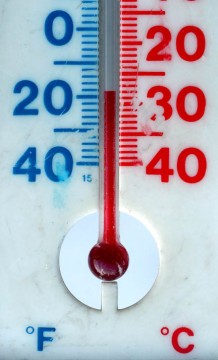
Bob King
I know it's an El Niño winter. Observers in my part of the world have benefited from warmer than normal temperatures, though sometimes at the expense of long stretches of overcast skies. Recently the weather returned to a more familiar pattern with snow followed by wicked cold fronts that plunge the mercury to 20 below under cloudless, nighttime skies.
Orion twinkles invitingly, but let's be honest, it takes a special kind of fortitude to venture outside with a telescope or binoculars. Staying warm feels more like an exercise in staying alive. But how else to explore, enjoy, and contemplate the beauty and bounty of the winter sky?
Long ago, I realized that proper dressing and constant movement meant I'd rarely need to miss a night. So why did I ignore my own advice two weeks ago on a windy, –18°F morning when I got up at dawn to photograph Saturn and Venus paired in Scorpius?
I sometimes use a plastic diffusion filter in front of the camera lens to "expand" the brighter stars, so they more closely resemble the naked eye view. Thinking I could handle a few seconds of biting wind, I made the mistake of holding the filter with bare, ungloved fingertips for several exposures.
Bad idea. My right thumb and index finger are still recovering from a case of superficial frostbite. I figured I'd do penance by using the incident to reinforce the importance of not underestimating the cold when it comes to observing in the winter. There aren't many things colder than amateur astronomy in January. Ice fishing maybe? Nights are colder than days, and looking through a telescope often involves standing still for five minutes or more at a time.
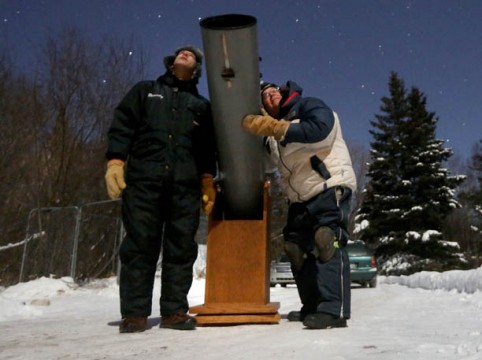
Bob King
I've lived in Duluth, Minnesota, for most of my life and learned long ago to always keep a parka handy even on early summer nights, when temperatures can dip to just above freezing. I don gloves when I'm out for an hour or two at 40°F to bring needed warmth and relaxation to my chilled fingers. Since heat often escapes through the head, a hat is a must when observing on damp spring and summer nights. I tend to lose a lot of heat from around the neck; a scarf helps to hold in precious warmth. As the red liquid in the thermometer compresses toward the freezing mark, long underwear becomes essential. Cotton, polyester — whatever feels comfortable. Pair them with lined pants and a sweater under your coat, and you're nearly invincible. Unless there's a wind.
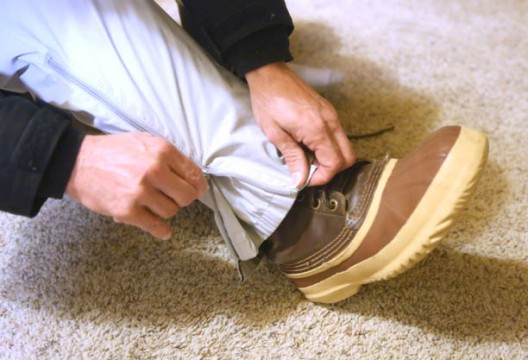
Bob King
Wind changes everything. You've probably experienced how a wind at 32°F can quickly creep up on you. You step outside at night into a mild breeze and think nothing of it. An hour later your bones are clattering. Wind and freezing temps call for extra layers and padding: a sweater or vest under the parka, insulated snow pants, a fur-flapped bomber hat, and heavier gloves. Without a wind, this wardrobe will make your observing session feel like a walk on the beach. Be careful to dress slowly and deliberately. If you break a sweat while suiting up, it will come back to haunt (and chill!) you.
Once the air temperature dives into the 20s and single digits, I dig out the heavy, wool-lined pack boots from the big cardboard box in the basement and park them next to the front door for the remainder of winter. Boots, flappy bomber hat, long underwear, insulated pants, wool socks, sweater, scarf, and a long-tailed down parka have served me well through the years on the coldest nights imaginable. Again, provided there's little wind.
On blustery, subzero nights when I absolutely must see that newly discovered supernova or comet, I limit the time spent outside to an hour before either coming inside the house to warm up or packing up the car and driving home. Bitter cold for me begins at –20°F and that means keeping moving and never exposing bare skin to the cold (ahem).
Standing around makes a body cool down fast — especially toes and fingers. Since I do a fair amount of observing away from the comforts of home, I make a point of pacing around or leaving eyepieces back in the car so I'm forced to walk back and forth from the telescope more frequently. When despite my best efforts, the cold starts creeping up my back, it's time to go for a walk. At the risk of sounding like a goofball, I either run in place for several minutes or walk a quarter mile down the road and back to keep the blood flowing.

Bob King
I asked a bunch of construction workers the other day what they do to stay warm when working outside for long hours in the winter, and they concurred: keep moving. One of them, Jonathan Olson of Superior, Wisconsin, put it more colorfully, explaining that "the heat's in the tools." Staying warm for them means continually working and moving with tools.
Returning to the telescope, I remind myself never to touch metal with bare fingers even for a second. Some of my observing friends wear two pairs of gloves — a fingered pair, for fine manipulation and protection against the pain of cold metal, tucked inside a heavy set of "choppers" or mittens.
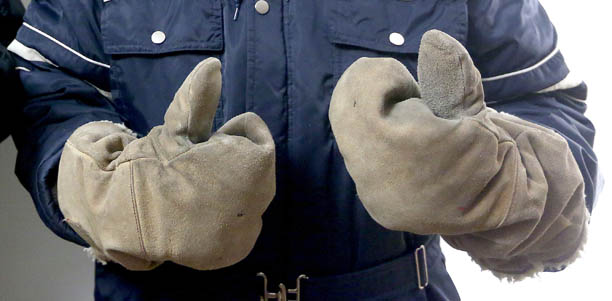
Bob King
Cold will eventually force an observer to close up shop. When you flick on your flashlight to disassemble the telescope, the tube or shroud often sparkles with a splendid coating of frost crystals. You'll also notice how much dexterity you've lost in your cold-numb hands. Good luck using your fingers to loosen the screws holding your finderscope in its dovetail mount.
Keeping back the cold also means it takes close to twice as much time to map a path to and find a specific object in the sky if you're not using a go-to setup. I keep my observing list short on exceptionally cold nights.
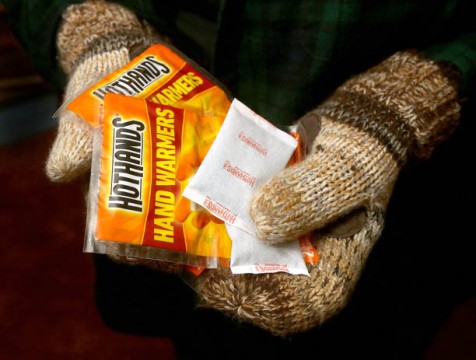
Bob King
Over the last several years I've become a convert of chemical hand warmers. Tear open a pack, give each packet a little shake, and you've got 10 hours of toasty heat in the palm of your hand or under your toes. One friend uses one for each palm and another set over the top of his hands. Another suggests taping them to your inner wrist and then covering with a glove or mitten. Since they don't heat the extremities, in particular those tender, essential fingertips useful for so many things, I'll just curl my fingers back into my palms to soak up a dose of heat when needed. Buy a box at the start of the cold weather season and always have them handy.
For Christmas my wife got me a chunky head-cowl and neck gaiter. I've avoided face masks over the years because my breath would always fog my glasses or the eyepiece, but the new, stretchy wool gaiter adjusts well and does a fantastic job of keeping neck and cheeks protected with a minimum of fogging.
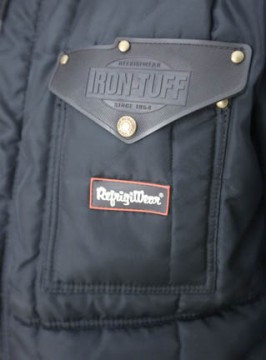
Bob King
Some observers like the one-piece coverall approach to cold weather observing. My buddy Aaron swears by his "Iron-Tuff" RefrigiWear suit. When hooded and zipped, body heat remains trapped inside, keeping him comfortable in the most frigid weather. I would not be lying if I told you he's been known to nap on his back in the driveway when taking a break from observing on long winter nights at the telescope. One-piece snowmobile suits offer similar protection.
Some people like light-weight synthetics in their coats and coveralls, but I've found that down keeps me warmest. The more the better. A long coat that covers your rear end will also make a huge difference in keeping warm compared to one that ends at the waist.
Battery-heated gloves and coats are also available though they're not cheap. Maybe as I get older and less able to cope, I'll consider a purchase. If anyone has used them, I'd love to hear how well they work. What we amateur astronomers really need is some way to convert all the starlight we spend time under into useful energy to keep us warm.
 8
8
Comments
Alan MacRobert
January 27, 2016 at 4:02 pm
If I'm within 100 feet of an electric outlet, I sometimes button a 50-watt hotpad inside my coat and sweater. Especially for observing that's protracted and motionless, like meteor counting. Your blood carries some of the extra heat to all extremities.
You must be logged in to post a comment.
Bob KingPost Author
January 28, 2016 at 8:59 am
Alan,
That must really feel good. A great idea for meteor observing that I could do because at least that I do from home. My cold issues come from driving out to sites in the country that sometimes provide little to no shelter from the wind.
You must be logged in to post a comment.
Chris Lee
January 27, 2016 at 5:56 pm
Nice article, we run this one on our website every year as well for our members. http://www.novac.com/wp/blog/the-ironmans-tips-for-staying-comfortable-while-observing-in-cold-weather/
You must be logged in to post a comment.
Bob KingPost Author
January 29, 2016 at 4:54 pm
Very nice Chris - you covered it all. Thanks for the link!
You must be logged in to post a comment.
January 30, 2016 at 1:46 am
One of my astronomy buddies uses a hot water bottle hanging from a cord around his neck to keep warm. A metal water bottle inside a sock and tucked between coat and sweater keeps your core nice and warm, and you can reach inside your coat with your hands for a quick warm-up of your fingers when they get cold. If you use hot tea or cocoa instead of water, you can even drink it for a pick-me-up.
I'm also a big fan of ski pants. Legs can radiate a lot of heat through a single pair of jeans.
You must be logged in to post a comment.
Gordon Hommes
January 31, 2016 at 2:14 pm
Hi Bob, I live and observe just north of you--in the highlands north of Two Harbors, MN --and often wonder just how many of us are out observing on those sub-zero, crystalline nights. If it's not windy I like to wear two pairs of fleece pants over my long johns, where I can keep eyepieces warm in the pockets without them getting scratched.
A thick, closed-cell foam pad is also used while sitting in my observing chair, or when kneeling on the snow.
Thanks for your great posts!
You must be logged in to post a comment.
January 31, 2016 at 7:53 pm
It does get cold in central Texas - nothing like Minnesota, but into the twenties. Wearing two pairs of socks helps and a balaclava (covering all of the head and neck except the face) are good. Somewhere I read to dress more warmly than you think you'll need and that has been true. Battery-powered socks have not worked well for me - hard to control the heat and they tend to overdo it. The perennial problem is fingers - mittens (not gloves) are best for warmth, but the worst for turning atlas pages or little screws. Down here it is warm enough to take them off periodically for those tasks. PS How would you like to be van Biesbroeck, measuring doubles all night at Yerkes (Wisconsin) in the dead of winter?
You must be logged in to post a comment.
Richard-Smith
February 1, 2016 at 12:53 am
I highly recommend non-cotton outer and under-clothes. Cotton holds moisture and will chill you, thus the saying "Cotton Kills."
You must be logged in to post a comment.
You must be logged in to post a comment.